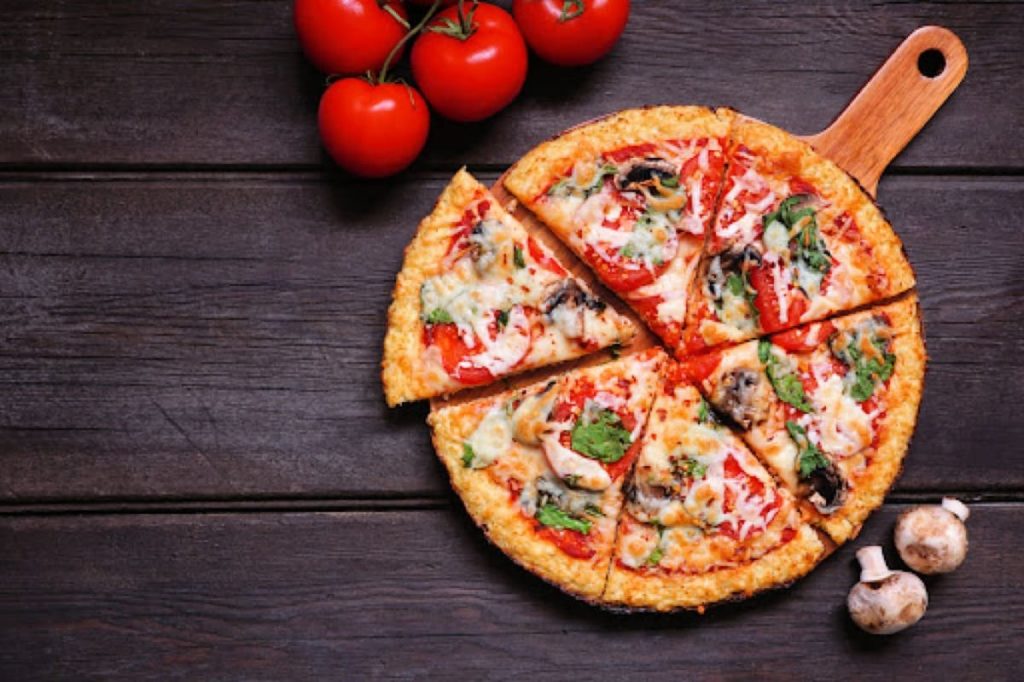What is a Gluten-free Pizza?
So, what exactly is a gluten-free pizza anyway? Scratch that, what is gluten and why is it in my pizza? Gluten is a protein that is found in wheat, rye, and barley. It’s the thing that allows doughs made from these grains to bind and rise into a bread consistency.
Normal pizza dough is made with wheat flour, which contains gluten. But for anyone with gluten insensitivity or celiac disease, gluten can cause serious health issues. That’s why, to be more accessible, Ambler Pizza offers a gluten-free option for pizza crust.
Our gluten-free pizza is not only safe for our gluten-intolerant customers: it’s also just as tasty as our regular pizzas!
Carbs In Gluten-Free Pizza Vs Regular Pizza
Back to the question at hand: how do gluten-free pizzas stand against regular pizzas in terms of carbs?
It depends…
There are a variety of flours and additives that can be used to make gluten-free pizza crust, some of which contain more and some of which have fewer carbohydrates than regular wheat flour.
So the answer to the question, are there fewer carbs in gluten-free pizza vs regular pizza, it depends. Just like with regular pizza, several factors go into telling you how healthy a pie is. The quality of ingredients, both in the crust and on the toppings, will have the most influence on the nutritional content.
Your choice of toppings has a big influence on how healthy your pizza is. Avoiding high-fat toppings like processed meats and extra cheese will make a pizza healthier no matter what kind of crust it has. The sauce makes a big difference too! Picking toppings and sauces that are lower fat and sugar and higher protein and fiber can turn pizza from a guilty pleasure to a solid meal.
What are Gluten-free Pizzas Made Of?
Gluten-free pizzas can be made from a variety of ingredients. Alternative flours such as rice or almond are classics, along with additives such as potato and tapioca starch. Some gluten-free pizzas are made from a combination of ingredients, and can even include vegetables such as cauliflower or butternut squash.
You can even make pizza crust out of cooked chicken! Many gluten-free crusts include cheese, spices, and other additives to give a unique, tasty flavor.
What’s The Point of a Gluten-Free Diet in General? Are They Healthier?
Most people tend to think that gluten-free pizzas have fewer carbs, which doesn’t seem to be the case every time. In fact, depending on the content, they could have more carbs than a regular pizza. So, what’s the point of a gluten-free diet in general?
For those with Celiac or a wheat allergy, having gluten present in their food can be painful and dangerous. But for those who don’t have these serious health issues, a lower-gluten diet can still be a good option. Many people in America are mildly sensitive to gluten, so for them, consuming less gluten reduces bloating, cramping, joint pain, and more.
Are Gluten-Free Pizzas Better Than Regular Pizzas?
Aside from health or dietary reasons, would anyone choose gluten-free pizza based on taste alone? You could argue that this isn’t a fair comparison, since for so many people, there is a particular point, such as an allergy, in having gluten-free pizza. But for those who have a choice, there are still plenty of reasons to go gluten-free.
While gluten-free pizzas tend to have less flavorful crusts, they can be crispier and have a lovely texture. Some gluten-free pizzas are also good for specific diets, such as high-protein or high-fiber diets. While gluten-free crusts tend to be slightly lower in nutritious content, they can still be an appealing option even for those without gluten sensitivity or intolerance.
Aside from the question about carbs, gluten-free pizzas still hold their own vs regular pizzas.
Should You Order Gluten-Free Pizzas While Trying to Lose Weight?
Pizza might not be the first food you think of when you think of a weight-loss diet. But even in the most restrictive diets, you have to include some fun meals every now and then. Gluten-free pizza can be a slightly healthier option for that treat meal, depending on the diet.
Gluten-free options don’t mesh as well with some diets, such as the keto diet. The ketogenic or keto diet means sticking to low-carb, high-protein, and almost no-sugar foods. Most gluten-free pizza crusts are low-carb, but include quite a bit of starch to mimic the binding effect of gluten in regular dough. Starch is a complex carbohydrate that digests into a sugar, making it unideal for a keto diet.
Pizza will not be the meal that helps you lose weight. But gluten-free pizza can be a great option when you want to treat yourself while still eating a little bit healthier.
Thin Crust vs Thick Crust: Which Pizza Has More Carbs?
In a general sense, people think that thin crust pizzas have fewer carbs than thick crust pizzas. You might be surprised to learn however, that when it comes to overall nutritious content, it can be the other way around.
Thick crust pizza does have more carbs than thin crust, because it literally has more crust, the main source of carbs on a pizza. But even so, it tends to be lower calorie. Believe it or not, because they have more toppings, thin crust pizza, gluten free or not, has way more calories than thick crust. The calorie count will tend to be about the same for gluten-free vs regular pizza, depending on the toppings.
How to Eat Pizza in a Healthier Way?
Pizza might not be the healthiest meal, but it’s one of our favorites for a reason! Here are several small things you can do to enjoy pizza in a healthier way.
Anyone else remember their parents inexplicably putting a napkin on your pizza when you were a kid? Now that makes perfect sense: you gotta blot all that oil off! Pizza might be one of the tastiest of dishes but isn’t really that healthy. But the good news is, there are several things you can do to enjoy the great taste of a classic pizza in a healthier way.
Remember how we said that thin crust pizza has more calories than thick crust? That’s true, but still not the whole story. Thick crust pizza tends to have more empty calories in the crust, while most of the calories in thin crust pizza come from the delicious toppings. If you’re choosing healthy, high-quality toppings, thin crust pizza still comes out ahead.
The types of toppings you choose are important. Why not try a lower fat cheese option like feta or ricotta, or add some super greens like spinach or arugula? Little changes can make a big difference, and still taste delicious!
Another way to enjoy your pizza guilt-free is with portion control. It can be tempting to down half a pizza by ourselves, but with a little self control that pizza can go farther. You can find helpful tricks like putting your pizza on a plate and cutting the slices into smaller pieces here. Each meal will be slightly smaller, but still satisfying.
Final Thoughts
A gluten-free diet can be appealing to many groups, including those with serious health issues such as Celiac, those with milder gluten insensitivities, and those looking to eat healthier or lose weight. The question of carbs, calories, and nutritious content in gluten-free pizza vs regular pizza is a complicated one. Gluten-free pizza crust might be only a little bit lower-carb than regular pizza crust, but it is still a great option.

